Scottish Highland Games is coming to
Linden Mills Days on June 21, 2014.
Highland Games Events
The Highland Games are also known as "Highland Heavy Events" and even "Scottish Strong Man." They are the oldest organized sporting competition known to man, pre-dating even the Greek Olympics. While one does not have to be of Scottish descent to participate in the games (though some say it helps), the wearing of the kilt during competition is mandatory.
There are several distinct events that are contested among the athletes and the overall winner is determined by a compilation of scores from each event. An athlete may not take 1st place in any single event, but can still win the overall competition.
For the distance events and the caber, the athlete is given 3 attempts with the best score of the 3 counted toward the total. For example, in stone put an athlete may put the stone 30 feet on his first throw, then 31 feet and 31.5 on consecutive throws. In this scenario, 31.5 feet is his best throw, and that is the one that is recorded. Any ties are broken by next best distances. The athlete is required to stay within a throwing area that measures 4'6" wide and 7'6" to the back line. For the weight for distance events there is an additional 2 feet allowed to the back line for a total of 9'6". At the front of the throwing area is a (white) toe board called a "trig." The athlete may not go in front of the trig or touch the top of it. Going outside of the throwing box or in front of the trig during a throw will cause the judge to call "FOUL" and the attempt will not count.
In the height events (sheaf and weight over bar), the athlete is given 3 attempts at each height. Once the athlete misses all 3 attempts at a given height, he is out. An athlete has the option to "pass" at lower heights and wait until the bar is raised to a height that he knows he can readily make before entering the event. In this way he conserves energy for subsequent higher attempts (yes, there is a bit of strategy too!). But don't wait too long because if the athlete misses all 3 attempts when he first comes in, he will be done andmost likely finish last in the WOB event!
Golf is Scottish - but this ain't golf!! You are encouraged to cheer you athletes as they compete!!
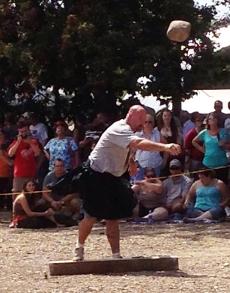
Stone Put
The stone put comes in 2 varieties: the open stone and the Braemar stone. The open stone is the forerunner to the Olympic shot put and the goal is the same - distance. The athlete stands in the throwing box behind the trig (trig = the white 6x6 piece of wood at the front of the throwing box, also called the toe board). The athlete can spin, glide or utilize the Braemar (standing still) technique. The stone is tucked against the neck and is put (thrown) with one hand. In open stone, the stone usually weighs about 16 or 17 pounds. During Braemar stone, the athlete is not allowed to glide or spin, but must remain still as he pushes the stone away. This is a test of brute strength as the Braemar stone usually weighs in excess of 20 pounds, sometimes approaching 30 pounds and is again put with one hand for distance.
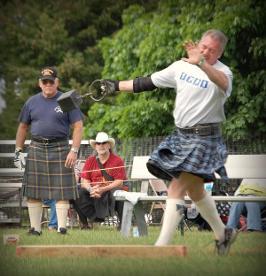
Weight for Distance
Here also the weight for distance comes in 2 varieties, heavy and light. The heavy weight weighs either 42 or 56 pounds. The light weight is 28 pounds. The weight is attached to a throwing handle (can be round or triangle shaped) via a chain and can be no more than 18 inches in total length. The athlete will start at the rear of the throwing box holding the weight with one hand and spin. The athlete must keep one foot inside of the throwing box at all times without going beyond the trig. After one or two spins while moving forward, the athlete will launch the weight with one hand. The goal is distance.
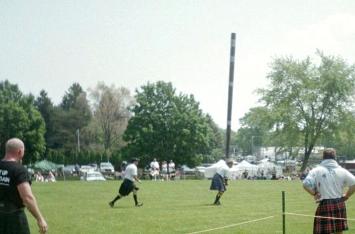
Caber Toss
This is the signature event of the Highland Games, and easily the most recognizable. A caber is quite simply a tree trunk. It can be anywhere from 18 to 22 feet in length. The weight also varies because no two trees are alike. This event is NOT about distance, but accuracy. Picture on the ground in front of the athlete a clock face, and straight ahead would be the 12:00 position. The goal of the athlete is to turn the caber end over end and have it fall away from him pointing at 12:00. If the athlete accomplishes this, the judge (following behind the athlete) will throw his hands up into the air, much like a football referee signaling a touchdown and shout, "Twelve O'clock!" - Perfect Turn! The caber may fall off to one side and the judge would call it as he sees it, and he may call 10:00, 1:15 or whatever he judges. If the caber does not go through the 90 degrees (isn't turned), the judge or maybe a second side judge will judge the turn on degrees - up to 90 degrees.
Below is the winning caber toss at the Tartan Sertoma Supreme Highland Games in Chatham, ON Canada. The caber in this video is 22 feet long.
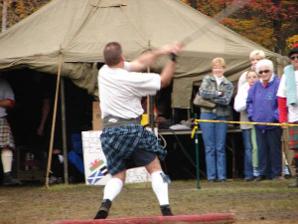
Hammer Throw
The hammer throw is the forerunner to the Olympic Hammer, with some differences. In Scottish hammer, the athlete will stand with his back to the throwing field. The athlete's feet must remain stationary as he winds the hammer over head. After several winds to gather speed, the hammer is released over the athletes shoulder onto the field for distance. Like other events, there at 2 varieties of Scottish Hammer - light and heavy. The light hammer weights 16 pounds and the heavy hammer weighs 22 pounds. You will also notice that many of the athletes have what look like blades protruding form the front of their shoes. These are called "hammer blades." The athlete will dig these blades into the ground to help keep his feet planted as he winds the hammer.
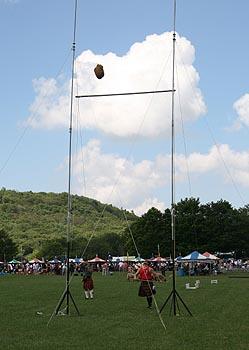
Sheaf Toss
Not "Sheep" toss!! This Highland Games event is practically an American exclusive! It is one of the 2 height events that are contested. A sheaf is a burlap bag that is filled with material (usually bailing twine) until it weighs between 16 and 25 pounds. The athlete will utilize a modified pitch fork to "toss" the bag over a bar for height. The bar is continually raised until the athlete can no longer toss the bag over.

Weight over Bar
Or "weight for height," also known as the "wob." In this other height event, the athlete will attempt to toss a 42 or a 56 pound weight over a bar for height using only one hand. Again the bar is incrementally raised until the athlete can no longer toss the weight over the bar. While there is a bit of technique to this event (such as sinking deep, using your whole body and not just your arm and knowing when to pull), this is also one of those "brute strength" events. And when you consider that this is usually the last event of the day that is contested, it sometimes take sheer willpower and determination to get that heavy weight up and over!